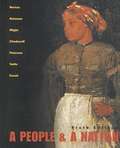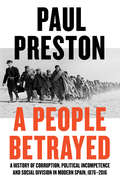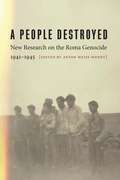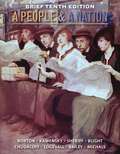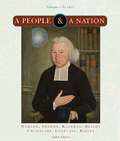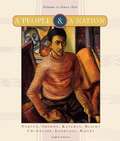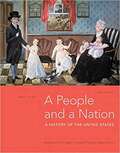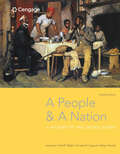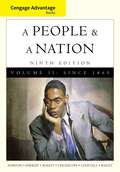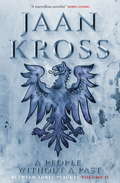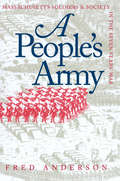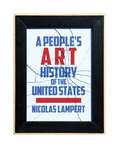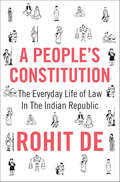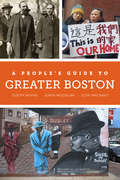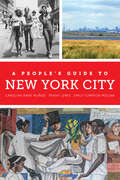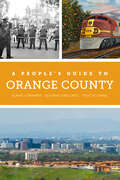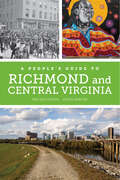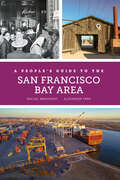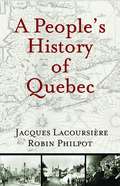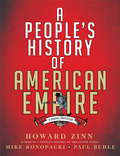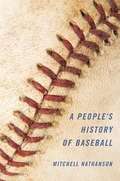- Table View
- List View
A People And A Nation: A History Of The United States Complete Sixth Edition
by David W. Blight David M. Katzman Mary Beth Norton Thomas G. Paterson Howard P. Chudacoff Paul D. Escott William M. Turtle Jr.A People and a Nation is a spirited narrative that challenges students to think about the meaning of American history. Its thoughtful inclusion of the lives of everyday people, cultural diversity, work, and popular culture preserves the text' s basic approach to American history as a story of all the American people.The end-of-chapter "Legacies for a People and a Nation" feature focuses on a specific event, movement, or fact covered in the chapter that shows a striking relevance to present-day events and controversies. The feature demonstrates how important the past is to the present and provides a forum for contemporary analysis.The "How Do Historians Know" feature demonstrates the process by which various pieces of historical evidence are used to reach conclusions about the past.
A People And A Nation: A History of the United States (7th edition)
by Beth Bailey David W. Blight David M. Katzman Mary Beth Norton Thomas G. Paterson Howard P. Chudacoff Fredrik Logevall William M. TuttleThis spirited narrative challenges students to think about the meaning of American history. Thoughtful inclusion of the lives of everyday people, cultural diversity, work, and popular culture preserves the text s basic approach to American history as a story of all the American people. The Seventh Edition maintains the emphasis on the unique social history of the United States and engages students through cutting-edge research and scholarship. New content includes expanded coverage of modern history (post-1945) with discussion of foreign relations, gender analysis, and race and racial relations. Chapter-based "Links to the World" connect US history to global events and provide web links for further research on topics such as international treaties and the AIDS epidemic. The end-of-chapter "Legacies for a People and a Nation" feature focuses on a meaningful event, movement, or fact covered in the chapter that bears a striking relevance to present-day issues or controversies. Revised and expanded, this feature includes coverage from civil rights to social security. Updated "Chronology Boxes" appear in every chapter to orient students to events and the dates of their occurrence.
A People Betrayed: A History Of Corruption, Political Incompetence And Social Division In Modern Spain
by Paul PrestonNowhere does the ceaseless struggle to maintain democracy in the face of political corruption come more alive than in Paul Preston’s magisterial history of modern Spain. The culmination of a half-century of historical investigation, A People Betrayed is not only a definitive history of modern Spain but also a compelling narrative that becomes a lens for understanding the challenges that virtually all democracies have faced in the modern world. Whereas so many twentieth-century Spanish histories begin with Franco and the devastating Civil War, Paul Preston’s magisterial work begins in the late nineteenth century with Spain’s collapse as a global power, especially reflected in its humiliating defeat in 1898 at the hands of the United States and its loss of colonial territory. This loss hung over Spain in the early years of the twentieth century, its agrarian economic base standing in stark contrast to the emergence of England, Germany, and France as industrial powers. Looking back to the years prior to 1923, Preston demonstrates how electoral corruption infiltrated almost every sector of Spanish life, thus excluding the masses from organized politics and giving them a bitter choice between apathetic acceptance of a decrepit government or violent revolution. So ineffective was the Republic—which had been launched in 1873—that it paved the way for a military coup and dictatorship, led by Miguel Primo de Rivera in 1923, exacerbating widespread profiteering and fraud. When Rivera was forced to resign in 1930, his fall brought forth a succession of feeble governments, stoking rancorous tensions that culminated in the tragic Spanish Civil War. With astonishing detail, Preston describes the ravages that rent Spain in half between 1936 and 1939. Tracing the frightening rise of Francisco Franco, Preston recounts how Franco grew into Spain’s most powerful military leader during the Civil War and how, after the war, he became a fascistic dictator who not only terrorized the Spanish population through systematic oppression and murder but also enriched corrupt officials who profited from severe economic plunder of Spain’s working class. The dictatorship lasted through World War II—during which Spain sided with Mussolini and Hitler—and only ended decades later, in 1975, when Franco’s death was followed by a painful yet bloodless transition to republican democracy. Yet, as Preston reveals, corruption and political incompetence continued to have a corrosive effect on social cohesion into the twenty-first century, as economic crises, Catalan independence struggles, and financial scandals persist in dividing the country. Filled with vivid portraits of politicians and army officers, revolutionaries and reformers, and written in the “absorbing” (Economist) style for which Preston is so revered, A People Betrayed is the first historical work to examine the continuities of political unrest and national anxiety in Spain up until the present, providing a chilling reminder of just how fragile democracy remains in the twenty-first century.
A People Destroyed: New Research on the Roma Genocide, 1941–1945
by Anton Weiss-WendtA People Destroyed features the most recent work on the Roma genocide in Europe during World War II. Despite the murder of a substantial part of the Romani population in various countries and occupied territories, it took historians more than half a century to collect enough evidence to establish the fact of genocide. Even today the public remains largely unaware of the extent of suffering that the Nazis and some of their allies inflicted on the Roma.A People Destroyed shows that the Nazis most consistently murdered Roma in the German-speaking countries and the occupied Soviet territories, while Fascist Croatia attempted its own &“Final Solution of the Gypsy Question.&” The history of persecution that Roma people endured in Europe laid the foundation for the Nazi policy of extermination. Anton Weiss-Wendt and the contributors to the volume, who come from nine different countries, build on existing Holocaust scholarship in their discussion of policy implementation, racial ideology, and the shared experiences of Jews and Roma. Meticulously analyzing diverse primary sources such as perpetrator documents and war crimes trial records, witness testimonies, population data, and contemporaneous newspaper reports and oral interviews, A People Destroyed provides a comprehensive overview of the destruction while focusing on the individual experiences of the victims.
A People and A Nation: A History of the United States (Brief Tenth Edition)
by Beth Bailey David W. Blight Carol Sheriff Mary Beth Norton Jane Kamensky Howard P. Chudacoff Fredrik Logevall Debra MichalsThe Brief Edition of A PEOPLE AND A NATION offers a succinct and spirited narrative that tells the stories of all people in the United States. The authors' attention to race and racial identity and their inclusion of everyday people and popular culture brings history to life, engaging readers and encouraging them to imagine what life was really like in the past.
A People and A Nation: A History of the United States Volume 1 To 1877
by David W. Blight Carol Sheriff David M. Katzman Mary Beth Norton Fredrik Logevall Howard ChudacoffA People and a Nation offers a spirited narrative that challenges students to think about American history. The authors' attention to race and racial identity and their inclusion of everyday people and popular culture brings history to life, engaging student readers and encouraging them to imagine what life was really like in the past. The Eighth Edition offers highly readable stories and the latest scholarship throughout.
A People and A Nation: Since 1865
by Beth Bailey David W. Blight Carol Sheriff David M. Katzman Mary Beth Norton Howard P. Chudacoff Fredrik LogevallA People and a Nation offers a spirited narrative that challenges students to think about American history. The authors' attention to race and racial identity and their inclusion of everyday people and popular culture brings history to life, engaging student readers and encouraging them to imagine what life was really like in the past. The Eighth Edition offers highly readable stories and the latest scholarship throughout.
A People and a Nation, Volume I: To 1877
by David W. Blight Carol Sheriff Jane Kamensky Fredrik Logevall Howard ChudacoffThink history is dull? No way, and you're about to find out for yourself. A PEOPLE AND A NATION offers a lively narrative, telling the stories of the diverse peoples in the United States. The authors bring history to life by encouraging you to imagine what life was really like in the past. Focus questions and key terms (with definitions, of course) help you concentrate on important information and easily review it as you prep for tests. And with MindTap for A People and a Nation, you get convenient digital access to an ebook with note-taking and other time-saving features and apps. You'll also explore the people, events and places in the United States through interactive activities, videos, images and maps. Enjoy your journey.
A People and a Nation: A History of the United States
by Beth Bailey David W. Blight Carol Sheriff Mary Beth Norton Jane Kamensky Howard P. Chudacoff Fredrik LogevallThink history is dull? No way, and you're about to find out for yourself. A PEOPLE AND A NATION offers a lively narrative, telling the stories of the diverse peoples in the United States. The authors bring history to life by encouraging you to imagine what life was really like in the past. Focus questions and key terms (with definitions, of course) help you concentrate on important information and easily review it as you prep for tests. And with MindTap for A People and a Nation, you get convenient digital access to an ebook with note-taking and other time-saving features and apps. You'll also explore the people, events and places in the United States through interactive activities, videos, images and maps. Enjoy your journey.
A People and a Nation: To 1877 (9th Edition)
by Beth Bailey David W. Blight Carol Sheriff Mary Beth Norton Fredrik Logevall Howard ChudacoffA PEOPLE AND A NATION is a best-selling text offering a spirited narrative that tells the stories of all people in the United States. The authors' attention to race and racial identity and their inclusion of everyday people and popular culture brings history to life, engaging readers and encouraging them to imagine what life was really like in the past.
A People and a Nation: Vol. II, Since 1865 (Ninth Edition)
by Beth Bailey David W. Blight Carol Sheriff David M. Katzman Mary Beth Norton Fredrik Logevall Howard ChudacoffDeveloped to meet the demand for a low-cost, high-quality history book, this economically priced version of A PEOPLE AND A NATION, Ninth Edition, offers readers the complete text while limiting the number of features, photos and maps. All volumes feature a paperback, two-color format that appeals to those seeking a comprehensive, trade-sized history text. A PEOPLE AND A NATION is a best-selling text offering a spirited narrative that tells the stories of all people in the United States. The authors' attention to race and racial identity and their inclusion of everyday people and popular culture brings history to life, engaging readers and encouraging them to imagine what life was really like in the past.
A People without a Past: Between Three Plagues Volume 2
by Jaan KrossThe second part in an epic historical trilogy - The Estonian answer to Wolf Hall - by the nation's greatest modern writer The year is 1563, and by any account Balthasar Russow can be said to have risen in the world. Fresh from his studies in the German town of Stetten, he has assumed the role as pastor of Tallinn's Holy Ghost Church. Moreover, he is betrothed to a maiden of the town - much to the chagrin of her father, who has no wish to welcome peasant stock to the family when there is no shortage of upstanding young German men - and is poised to begin the chronicle that will ensure his everlasting fame.But tribulations still await the now not-quite-young Pastor - Livonia is still plagued by foreign powers, with Tallinn braced to withstand a prolonged Muscovite siege. And he will discover that marriage is a often a battlefield in itself.Translated from the Estonian by Merike Beecher
A People without a Past: Between Three Plagues Volume 2 (Between Three Plagues #2)
by Jaan KrossThe second part in an epic historical trilogy - The Estonian answer to Wolf Hall - by the nation's greatest modern writer The year is 1563, and by any account Balthasar Russow can be said to have risen in the world. Fresh from his studies in the German town of Stetten, he has assumed the role as pastor of Tallinn's Holy Ghost Church. Moreover, he is betrothed to a maiden of the town - much to the chagrin of her father, who has no wish to welcome peasant stock to the family when there is no shortage of upstanding young German men - and is poised to begin the chronicle that will ensure his everlasting fame.But tribulations still await the now not-quite-young Pastor - Livonia is still plagued by foreign powers, with Tallinn braced to withstand a prolonged Muscovite siege. And he will discover that marriage is a often a battlefield in itself.Translated from the Estonian by Merike Beecher
A People's Army
by Fred AndersonA People's Army documents the many distinctions between British regulars and Massachusetts provincial troops during the Seven Years' War. Originally published by UNC Press in 1984, the book was the first investigation of colonial military life to give equal attention to official records and to the diaries and other writings of the common soldier. The provincials' own accounts of their experiences in the campaign amplify statistical profiles that define the men, both as civilians and as soldiers. These writings reveal in intimate detail their misadventures, the drudgery of soldiering, the imminence of death, and the providential world view that helped reconcile them to their condition and to the war.
A People's Art History of the United States
by Nicolas LampertMost people outside of the art world view art as something that is foreign to their experiences and everyday lives. A People's Art History of the United States places art history squarely in the rough-and-tumble of politics, social struggles, and the fight for justice from the colonial era through the present day.Author and radical artist Nicolas Lampert combines historical sweep with detailed examinations of individual artists and works in a politically charged narrative that spans the conquest of the Americas, the American Revolution, slavery and abolition, western expansion, the suffragette movement and feminism, civil rights movements, environmental movements, LGBT movements, antiglobalization movements, contemporary antiwar movements, and beyond.A People's Art History of the United States introduces us to key works of American radical art alongside dramatic retellings of the histories that inspired them. Stylishly illustrated with over two hundred images, this book is nothing less than an alternative education for anyone interested in the powerful role that art plays in our society.
A People's Church: Medieval Italy and Christianity, 1050–1300
by Neslihan Şenocak Agostino Paravicini BaglianiA People's Church brings together a distinguished international group of historians to provide a sweeping introduction to Christian religious life and institutions in medieval Italy. Each essay treats a single theme as broadly as possible, highlighting both the unique aspects of medieval Christianity on the Italian peninsula and the beliefs and practices it shared with other Christian societies. Because of its long tradition of communal self-governance, Christianity in medieval Italy, perhaps more than anywhere else, was truly a "people's church." At the same time, its exceptional urban wealth and literacy rates, along with its rich and varied intellectual and artistic culture, led to diverse forms of religious devotion and institutions.Contributors: Maria Pia Alberzoni on heresy; Frances Andrews on urban religion; Cécile Caby on monasticism; Giovanna Casagrande on mendicants; George Dameron on Florence; Antonella Degl'Innocenti on saints; Marina Gazzini on lay confraternities; Maureen C. Miller on bishops; Agostino Paravicini Bagliani and Pietro Silanos on the papacy and Italian politics; Antonio Rigon on clerical confraternities; Neslihan Şenocak on the pievi and care of souls; Giovanni Vitolo on Naples.
A People's Constitution: The Everyday Life of Law In The Indian Republic (Histories of Economic Life #7)
by Rohit DeIt has long been contended that the Indian Constitution of 1950, a document in English created by elite consensus, has had little influence on India’s greater population. Drawing upon the previously unexplored records of the Supreme Court of India, A People’s Constitution upends this narrative and shows how the Constitution actually transformed the daily lives of citizens in profound and lasting ways. This remarkable legal process was led by individuals on the margins of society, and Rohit De looks at how drinkers, smugglers, petty vendors, butchers, and prostitutes—all despised minorities—shaped the constitutional culture.The Constitution came alive in the popular imagination so much that ordinary people attributed meaning to its existence, took recourse to it, and argued with it. Focusing on the use of constitutional remedies by citizens against new state regulations seeking to reshape the society and economy, De illustrates how laws and policies were frequently undone or renegotiated from below using the state’s own procedures. De examines four important cases that set legal precedents: a Parsi journalist’s contestation of new alcohol prohibition laws, Marwari petty traders’ challenge to the system of commodity control, Muslim butchers’ petition against cow protection laws, and sex workers’ battle to protect their right to practice prostitution.Exploring how the Indian Constitution of 1950 enfranchised the largest population in the world, A People’s Constitution considers the ways that ordinary citizens produced, through litigation, alternative ethical models of citizenship.
A People's Guide to Greater Boston (A People's Guide Series #2)
by Joseph Nevins Suren Moodliar Eleni MacrakisA People's Guide to Greater Boston reveals the region’s richness and vibrancy in ways that are neglected by traditional area guidebooks and obscured by many tourist destinations. Affirming the hopes, interests, and struggles of individuals and groups on the receiving end of unjust forms of power, the book showcases the ground-level forces shaping the city. Uncovering stories and places central to people’s lives over centuries, this guide takes readers to sites of oppression, resistance, organizing, and transformation in Boston and outlying neighborhoods and municipalities—from Lawrence, Lowell, and Lynn to Concord and Plymouth. It highlights tales of the places and people involved in movements to abolish slavery; to end war and militarism; to achieve Native sovereignty, racial equity, gender justice, and sexual liberation; and to secure workers’ rights. In so doing, this one-of-a-kind guide points the way to a radically democratic Greater Boston, one that sparks social and environmental justice and inclusivity for all.
A People's Guide to New York City (A People's Guide Series #5)
by Penny Lewis Emily Tumpson Molina Carolina Bank MuñozThis alternative guidebook for one of the world’s most popular tourist destinations explores all five boroughs to reveal a people’s New York City. The sites and stories of A People’s Guide to New York City shift our perception of what defines New York, placing the passion, determination, defeats, and victories of its people at the core. Delving into the histories of New York's five boroughs, you will encounter enslaved Africans in revolt, women marching for equality, workers on strike, musicians and performers claiming streets for their art, and neighbors organizing against landfills and industrial toxins and in support of affordable housing and public schools. The streetscapes that emerge from these groups' struggles bear the traces, and this book shows you where to look to find them. New York City is a preeminent global city, serving as the headquarters for hundreds of multinational firms and a world-renowned cultural hub for fashion, art, and music. It is among the most multicultural cities in the world and also one of the most segregated cities in the United States. The people that make this global city function—immigrants, people of color, and the working classes—reside largely in the so-called outer boroughs, outside the corporations, neon, and skyscrapers of Manhattan. A People’s Guide to New York City expands the scope and scale of traditional guidebooks, providing an equitable exploration of the diverse communities throughout the city. Through the stories of over 150 sites across the Bronx, Manhattan, Queens, Brooklyn and Staten Island as well as thematic tours and contemporary and archival photographs, a people’s New York emerges, one in which collective struggles for justice and freedom have shaped the very landscape of the city.
A People's Guide to Orange County (A People's Guide Series #4)
by Gustavo Arellano Thuy Vo Dang Elaine LewinnekThe full and fascinating guidebook that Orange County deserves.A People’s Guide to Orange County is an alternative tour guide that documents sites of oppression, resistance, struggle, and transformation in Orange County, California. Orange County is more than the well-known images on orange crate labels, the high-profile amusement parks of Disneyland and Knott’s Berry Farm, or the beaches. It is also a unique site of agricultural and suburban history, political conservatism in a liberal state, and more diversity and discordance than its pop-cultural images show. It is a space of important agricultural labor disputes, segregation and resistance to segregation, privatization and the struggle for public space, politicized religions, Cold War global migrations, vibrant youth cultures, and efforts for environmental justice. Memorably, Ronald Reagan called Orange County the place "where all the good Republicans go to die," but it is also the place where many working-class immigrants have come to live and work in its agricultural, military-industrial, and tourist service economies. Orange County is the fifth-most populous county in America. If it were a city, it would be the nation’s third-largest city; if it were a state, its population would make it larger than twenty-one other states. It attracts 42 million tourists annually. Yet Orange County tends to be a chapter or two squeezed into guidebooks to Los Angeles or Disneyland. Mainstream guidebooks focus on Orange County’s amusement parks and wealthy coastal communities, with side trips to palatial shopping malls. These guides skip over Orange County’s most heterogeneous half—the inland space, where most of its oranges were grown alongside oil derricks that kept the orange groves heated. Existing guidebooks render invisible the diverse people who have labored there. A People’s Guide to Orange County questions who gets to claim Orange County’s image, exposing the extraordinary stories embedded in the ordinary landscape.
A People's Guide to Richmond and Central Virginia (A People's Guide Series #6)
by Melissa Dawn OotenAn expansive guide for resistance and solidarity across this storied region. Richmond and Central Virginia are a historic epicenter of America’s racialized history. This alternative guidebook foregrounds diverse communities in the region who are mobilizing to dismantle oppressive systems and fundamentally transforming the space to live and thrive. Featuring personal reflections from activists, artists, and community leaders, this book eschews colonial monuments and confederate memorials to instead highlight movements, neighborhoods, landmarks, and gathering spaces that shape social justice struggles across the history of this rapidly growing area. The sites, stories, and events featured here reveal how community resistance and resilience remain firmly embedded in the region’s landscape. A People’s Guide to Richmond and Central Virginia counters the narrative that elites make history worth knowing, and sites worth visiting, by demonstrating how ordinary people come together to create more equitable futures.
A People's Guide to the San Francisco Bay Area (A People's Guide Series #3)
by Rachel Brahinsky Alexander TarrAn alternative history and geography of the Bay Area that highlights sites of oppression, resistance, and transformation.A People’s Guide to the San Francisco Bay Area looks beyond the mythologized image of San Francisco to the places where collective struggle has built the region. Countering romanticized commercial narratives about the Bay Area, geographers Rachel Brahinsky and Alexander Tarr highlight the cultural and economic landscape of indigenous resistance to colonial rule, radical interracial and cross-class organizing against housing discrimination and police violence, young people demanding economically and ecologically sustainable futures, and the often-unrecognized labor of farmworkers and everyday people.The book asks who had—and who has—the power to shape the geography of one of the most watched regions in the world. As Silicon Valley's wealth dramatically transforms the look and feel of every corner of the region, like bankers' wealth did in the past, what do we need to remember about the people and places that have made the Bay Area, with its rich political legacies? With over 100 sites that you can visit and learn from, this book demonstrates critical ways of reading the landscape itself for clues to these histories. A useful companion for travelers, educators, or longtime residents, this guide links multicultural streets and lush hills to suburban cul-de-sacs and wetlands, stretching from the North Bay to the South Bay, from the East Bay to San Francisco. Original maps help guide readers, and thematic tours offer starting points for creating your own routes through the region.
A People's History Of Quebec
by Robin Philpot Jacques LacoursièreRevealing a little-known part of North American history, this lively guide tells the fascinating tale of the settlement of the St. Lawrence Valley. It also tells of the Montreal and Quebec-based explorers and traders who traveled, mapped, and inhabited a very large part of North America, and ?embrothered the peoples” they met, as Jack Kerouac wrote.Connecting everyday life to the events that emerged as historical turning points in the life of a people, this book sheds new light on Quebec's 450-year history??and on the historical forces that lie behind its two recent efforts to gain independence.
A People's History of American Empire
by Howard ZinnSince its landmark publication in 1980, the original history has sold more than 1.7 million copies. More than a successful book, it triggered a revolution in the way history is told, displacing the official versions with their emphasis on great men in high places to chronicle events as they were lived, from the bottom up.Historians Howard Zinn and Paul Buhle and cartoonist Mike Konopacki have collaborated to retell, in vibrant graphic form, a most immediate and relevant chapter of A People's History of American Empire: the story of America's ever-growing role on the world stage. Narrated by Zinn, this version opens with the events of 9/11 and then tracks back to explore the cycles of US expansionism from Wounded Knee to Iraq, while taking in World War I, Central America, Vietnam, and the Iranian revolution.The book also follows the story of Zinn, the son of poor Jewish immigrants, from his childhood in the Brooklyn slums to his role as one of America's leading historians. Shifting from world-shattering events to one family's small revolutions, this is a classic ground-level history of America in a dazzling new form.
A People's History of Baseball
by Mitchell NathansonFrom its first pitch, baseball has reflected national values and promoted the idea of what it means to be American. Beloved narratives tied the national pastime to beliefs as fundamental to our civic life as racial equality, patriotism, heroism, and virtuous capitalism. Mitchell Nathanson calls foul. Rejecting the myths and much-told tales, he examines how power is as much a part of baseball--and America--as pine tar and eye black. Indeed, the struggles for power within the game paralleled those that defined our nation. Nathanson follows the new Americans who sought club ownership to promote their social status in the increasingly closed caste system of nineteenth-century America. He shows how the rise and public rebuke of the Players Association reflects the collective spirit of working and middle-class America in the mid-twentieth century and the countervailing forces that sought to beat back the emerging movement. He lays bare the debilitating effects of a harsh double standard that required African American players to possess an unimpeachable character merely to take the field--a standard no white player had to meet. Told with passion and righteous outrage, A People's History of Baseball offers an incisive alternative history of America's much-loved--if misunderstood--national pastime.
